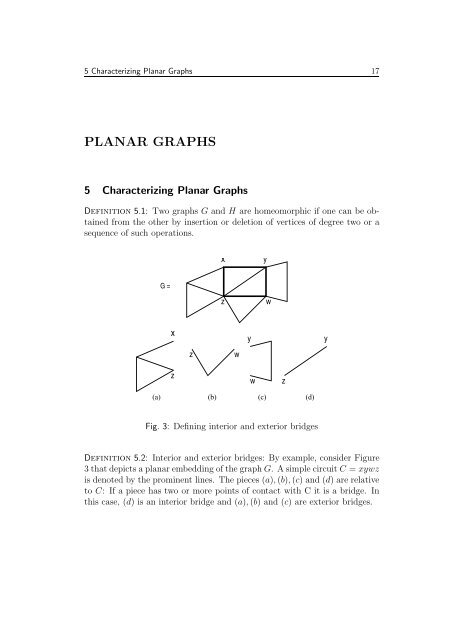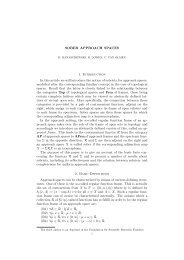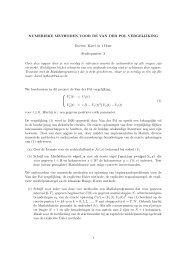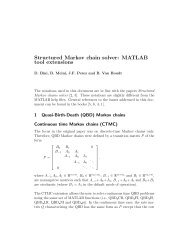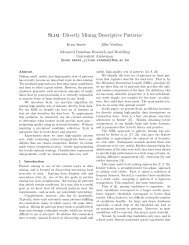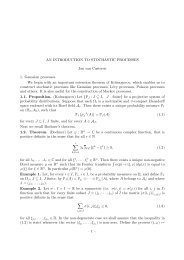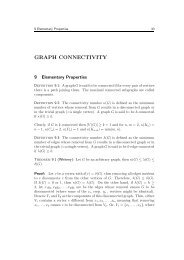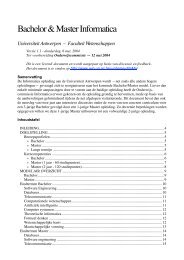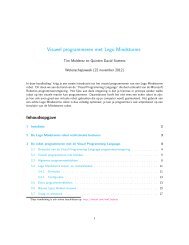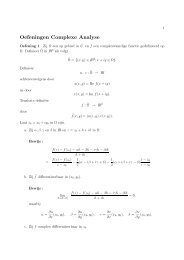PLANAR GRAPHS
PLANAR GRAPHS
PLANAR GRAPHS
Create successful ePaper yourself
Turn your PDF publications into a flip-book with our unique Google optimized e-Paper software.
5 Characterizing Planar Graphs 17<strong>PLANAR</strong> <strong>GRAPHS</strong>5 Characterizing Planar GraphsDefinition 5.1: Two graphs G and H are homeomorphic if one can be obtainedfrom the other by insertion or deletion of vertices of degree two or asequence of such operations.xyG =zwxzwyyzwz(a) (b) (c) (d)Fig. 3: Defining interior and exterior bridgesDefinition 5.2: Interior and exterior bridges: By example, consider Figure3 that depicts a planar embedding of the graph G. A simple circuit C = xywzis denoted by the prominent lines. The pieces (a), (b), (c) and (d) are relativeto C: If a piece has two or more points of contact with C it is a bridge. Inthis case, (d) is an interior bridge and (a), (b) and (c) are exterior bridges.
5 Characterizing Planar Graphs 18Before we prove the celebrated Kuratowski theorem, one should notice thefollowing. Since any planar graph can be embedded on a sphere, any areacan be nominated the infinite area. Meaning that for any edge xy of a planargraph G, we can draw G in such a way that xy bounds the infinite area.Theorem 5.1 (Kuratowski (1930)): A graph is non planar if and only if itcontains a subgraph homeomorphic to K 5 or K 3,3 .Proof: (⇐) K 5 and K 3,3 are non planar, so if G contains a subgraph homeomorphicto K 5 or K 3,3 it too must be non planar.(⇒) Assume that the theorem is not true. Consider the set of counter exampleswith the smallest number of edges E. Let G be a member of this setwith the least number of vertices. Denote E(G) = N, clearly G is non planarand does not contain a subgraph homeomorphic to K 5 or K 3,3 . For such agraph G the following statements hold:(1) G is connected. Assume that G is disconnected, in which case it mustconsist of components c 1 , c 2 , . . .,c k (k ≥ 2). Subsequently, E(c i ) for eachi = 1, . . .,k must be less than N (the case where E(c i ) = 0 for all c i but oneis covered by the fact that the order of G is minimal). Since G does not containa subgraph homeomorphic to K 5 or K 3,3 , neither do c i (i = 1, 2, . . ., k)and hence c 1 , c 2 , . . ., c k are planar. If the components are planar then G toomust be planar. Hence, by contradiction, G must be connected.G=vG* =vvvc1 c2 c3Fig. 4: G holds a cut vertex v
5 Characterizing Planar Graphs 19(2) G does not contain a cut vertex, meaning we cannot disconnect G byremoving a single vertex v. Assume that G contains a cut vertex v and letG ∗ be G with a separation at v (see Figure 4). Since G ∗ is disconnected, itmust consist of components c i (i = 1, 2, . . .,n). Each c i does not contain asubgraph homeomorphic to K 5 or K 3,3 , since G does not contain such a subgraph.Therefore, since E(c i ) < N (i = 1, 2, . . ., n), each c i is planar. Now,v can be moved, in each case, to be incident to the exterior area. In this waythe components can be rejoined to give a planar G and so, by contradiction,G does not contain a cut vertex.G’xTyXxTTyY(a)E(x,T)(b)E(y,T)XxE(x,T)E(y,T)yYT(c)Fig. 5: G ′ holds a circuit through x and y(3) Let e(x, y) be the edge from x to y. Let G ′ be G with e(x, y) omitted.G ′ contains a simple circuit through x and y. Indeed, since G contains nocut vertex (due to (2)), G ′ is connected (otherwise x would be a cut vertex).Now, assume that such a circuit does not exist, in which case a vertex, Tsay, exists of the form shown in Figure 5(a), see Menger’s Theorem. Underseparation X and Y are formed as shown in Figure 5(b) by adding an edgee(x, T) and an edge e(y, T). Since G contains a subgraph homeomorphicto X (because T is connected to y and e(x, y) was part of G) and anotherhomeomorphic to Y , X and Y do not contain subgraphs homeomorphic toK 5 or K 3,3 . Moreover, E(X) < N and E(Y ) < N, so X and Y are planar.X and Y can be transformed such that e(y, T) and e(x, T) lie incident to the
5 Characterizing Planar Graphs 20exterior area and be brought together as shown in Figure 5(c). Now, deletinge(x, T) and e(y, T) and adding e(x, y) must therefore give a plane representationof G. So, by contradiction, G must contain simple circuit from x to y.We have now deduced: (i) G ′ = G − e(x, y) is connected and contains asimple circuit C through x and y, (ii) G ′ contains no subgraph homeomorphicto K 5 or K 3,3 , and (iii) Since E(G) = N and E(G ′ ) = N −1, G ′ is planar.Let G ′ p be a planar embedding of G′ and let C be a circuit through x andy such that it encloses as many areas as possible. Denote the path from xto y inclusive by [x, y] and the path from x to y non inclusive by (x, y). Noexterior bridge can have more than one point of contact with C in [x, y] or[y, x], or else a circuit C could be found that encloses at least one more area.Now, consider the interior and exterior bridges of G ′ p with respect to C sothat G will be non planar. There must be at least one exterior (E) and oneinterior (I) bridge or else G would be planar (by drawing e(x, y) as an interiorresp. exterior bridge). E must have contact points i and j with C, such thati ∈ (x, y) and j ∈ (y, x), and I must have at least 2 contact points a and bwith C such that a ∈ (x, y) and b ∈ (y, x) (such a bridge I exists as e(x, y)could otherwise be drawn as an interior bridge). The 4 possibilities whichmeet this criteria are given by Figure 6 (case (C) and (D) are equivalent).The graph drawn in scenario A has a subgraph homeomorphic to K 3,3 (i.e.,{i, b, x}, {j, a, y}). In the other 4 scenarios the interior bridge I can still bedrawn as an exterior bridge. We have chosen this interior bridge I such thatit cannot be drawn as an exterior bridge without violating the planarity ofG ′ p (indeed, if all interior bridges could be drawn on the outside then drawinge(x, y) as an interior bridge would make G planar), thus there is eitheranother exterior bridge E ′ that prevents this, which implies that we end upin scenario A, with E ′ playing the role of E (because all exterior bridges have1 contact point on (x, y) and 1 on (y, x)). Or I has at least one more contactpoint c that prevents us from drawing I as an outside bridge. Let us discussthese 4 scenarios one at a time.In scenario C we need to add c on (j, i). However adding c on (x, i) wouldresult in scenario A (where c plays the role of a); hence, we add c on (j, x](see Figure 7C). We know prove that this graph contains a subgraph homeomorphicto K 3,3 . The bridge I contains a vertex v such that there are 3
5 Characterizing Planar Graphs 21AaiBa,iCa,ixyxyxyjbb,jjbDa,iEiaxyxybjjbFig. 6: 5 possible scenariosvertex-distinct paths from v to a, b and c 4 . As a result, {a, b, c} and {v, j, y}form the vertices of a subgraph of G which is homeomorphic to K 3,3 . Similarly,in scenario D we need to add c on [y, j) and {a, b, c} and {v, j, x} formthe vertices of a subgraph of G which is homeomorphic to K 3,3 (see Figure7D). Also, in scenario E, c needs to coincide with x, otherwise if c was partof (j, x) or (x, i) and we end up in scenario A. As a result, {a, b, x} and{v, y, i} form the vertices of a subgraph of G which is homeomorphic to K 3,3(see Figure 7E).In scenario B, we need to add two contact points c and d (otherwise we couldstill draw I on the outside), one on (j, i) and one on (i, j). If either c or ddo not coincide with x or y, we end up in scenario C or D. Thus, c has tocoincide with x and d with y. We distinguish 2 cases: (i) there exists a vertexv in I such that there are 4 vertex-distinct paths from v to a, b, c and d (seeFigure 7B2). In this case v, a, b, c and d form the vertices of a subgraph of Gwhich is homeomorphic to K 5 . (ii) if there is no such vertex v, then 2 verticesw 1 and w 2 exist 5 such that there are 5 vertex-distinct paths: one from w 1 to4 Indeed, let P be a path from a to b on I and w a vertex on this path, then setting vequal to the first common vertex of P and a path P ′ from c to w in I − {a, b} suffices.5 Indeed, there exists a v such that there are vertex-distinct paths from v to a, b and c
6 Maximal Planar Graphs 22Ca,iDa,iEiaxyx y x,cycjbbjcjbB1a,iB2a,ix,cy,dx,cy,db,jb,jFig. 7: 5 remaining casesw 2 , two from w 1 to a and c, and two from w 2 to b and d (see Figure 7B1). Asa result, {w 1 , b, d} and {a, c, w 2 } form the vertices of a subgraph of G whichis homeomorphic to K 3,3 .Q.E.D.Exercises 5.1: On the Kuratowski Theorem:1. Check whether the Petersen graph is planar.2. Determine the number of non planar graphs G with 6 vertices.6 Maximal Planar GraphsDefinition 6.1: A maximal planar graph G is a planar graph to which nonew edge can be added without violating the planarity of G. A triangulationis a planar graph G in which every area (region) is bounded by three edges.Theorem 6.1: The following statements are equivalent for a graph G withn G vertices and e G edges:(in I). Now, there is also a path from d to c and G ′ is planar. Thus, thus the path from dto c has to connect to the path from a to b at some point. Without loss of generality weassume that this happens below v.
6 Maximal Planar Graphs 231. G is maximal planar.2. G is a triangulation.3. e G = 3n G − 6 and G is planar.Proof: (1 ⇒ 2) Suppose there is a planar representation of G that containsan area A bounded by 4 or more edges. Two vertices x and y incident to Aexist such that xy ∉ E(G), otherwise we could add a vertex in the interiorof A to obtain a planar representation of K 5 . Drawing the edge xy in theinterior of A does not violate the planarity of G.(2 ⇒ 3) G is a triangulation, therefore, 3f = 2e. Applying Euler’s equalityfor planar graphs we find 3n − e = 6.(3 ⇒ 1) Earlier in the course, we saw that e ≤ 3n − 6 for any planar graphG. Adding an edge thus violates the planarity of G.Q.E.D.Exercises 6.1: On Maximum Planarity:1. Draw all regular maximum planar graphs, i.e., δ(G) = ∆(G).Exercises 6.2: On Outer Planarity: A graph is called outer planar if it canbe embedded in the plane such that all vertices lie on the boundary of theunbounded area.1. Let G be outer planar, then prove that e ≤ 2n − 3.2. Show that χ(G) ≤ 3 if G is outer planar.3. Prove that a graph is outer planar if and only if it contains no subgraphhomeomorphic with K 4 or K 3,2 .


